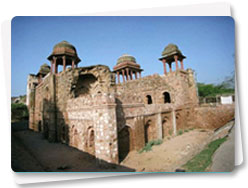Eight Cities of Delhi
SUCCESSIVE CITIES OF DELHI
Three things make a city - Daria, Badal, Badshah.
This is to say, a river, rain- bringing clouds, or an emperor
(who can enforce his wishes)
This is to say, a river, rain- bringing clouds, or an emperor
(who can enforce his wishes)
Native proverb

We face the good and the bad of India in Delhi city which has been the grave of many empires and the nursery of a republic. What a tremendous story of hers! Here the tradition of millennia of our history surrounds us at every step, and the procession of innumerable generations passes by before our eyes"
Prime Minister Jawaharlal Nehru
From Convocation Address of Delhi University
December, 1958
From Convocation Address of Delhi University
December, 1958
Delhi has a long history which despite occasional dislocation, has shown a remarkable continuity and has the unique distinction of having been India's capital longer than any other city. Ancient legend has that "he who rules Delhi, rules India". It has survived all the vicissitudes of time and fortune. Though it has frequently changed its site, its character and its name, it has throughout a continuous thread of existence it has seen the rise and fall of many civilizations. From Indraprastha of Mahabharat to the present New Delhi, it has grown into a mega metropolis. From the Dilli of Raja Dillu to the New Delhi, it has always commanded power.
The earliest reference to a settlement at Delhi is found in Mahabharata. King Dhratarshta of Hastinapur have the tracts around Delhi to Pandavas to set-up their Kingdom. This part of Delhi was known as Khandavaprastha. Yudhisthir, the Pandava prince, cleared the forest known as Khandavavan and established the city, Indraprastha, in Delhi. Indeed it was a formidable city so grand that it made kauravas the enemies of pandavas. From that period Delhi witnessed the rise and fall of many dynasties and Empires. The location of the city attracted Indian rulers of all kinds from ancient times because of its strategic and commercial value.
It would be easy to argue that the cities of Delhi were in reality less or more than seven. But the accepted number is seven (excluding New Delhi) and these are cities whose remains are extant. Historians speak of the "Seven Cities of Delhi" but, between 1100 A.D. and 1947 A.D., there have actually been eight of them:
- The oldest city near the site of the Qutab Minar
- Siri
- Tughlqabad
- Jahanpanah
- Firozobad
- The city around Purana Qila
- Shahjahanabad
- New Delhi
Each of the these cities grew round the palace - fortress of a particular dynasty and every dynasty wished to have a new headquarters for consideration of prestige. Even the Kings of the same dynasty had this ambitions, and realized it if they had the means to do so. With each successive reign, some distinctive architectural features was added or some change in urban morphology occurred. Often some important new buildings would, rise, something monumental - whether a mosque or a tomb, a palace, a fortress or a victory-tower.
The story of Delhi as the Capital of India began with theMuslim conquest of Northern India at the end of twelfth century. Since then, with some interludes, it has been the seat of every central political authority.
No comments:
Post a Comment